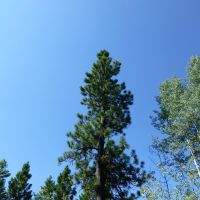This is a story of a beautiful wild bee. It is also the story of a beautiful wild flower that she adores. First, the flower. In a few spots on the grasslands where the Great North American Desert starts to blend in with the trees, meadow voles still till the soil and mariposa lilies still bloom (although lightly now) at the end of June. Here is a small colony in the needle-and-thread grass, bunchgrass, arrow-leafed balsam root, and sagebrush, their old friends from when these hills were fire-tilled gardens, managed and harvested by the Syilx people.
Fire hasn’t been seen here for ninety years.
Here’s what mariposa lilies look like just as they begin to open. It’s no surprise that they’re sometimes called grassland tulips, although it’s too bad that the colonial name makes them sound decorative, rather than the food staple that they were (their corms [think: bulbs] were strung on lines, hung in the smoke over cooking fires to dry, and then eaten the long winter through). Rarely has food looked so good.
A Winter Snack Blooming in Late June
Most of their charm, however, comes when you peer into their blooms, like, um, a giant bee, or the sun, that’s right. Just lean over, and peer right in, and …
Mariposa Lily in Full Glory
Well, I thought that was a mariposa lily in full glory, but then I peered into one and saw this…
Green Head Rising
At first, I thought it was a beetle, cuz I’ve seen green beetles like this all over in the hills and up into the plateau, but then it crawled out further (With a heavy load of pollen, half drunk on nectar, and caught like velcro by all the pollen filaments, it took a couple minutes to make the long climb…it was like birth itself.), and …
It’s a Bee!
She moved in short spurts of a couple centimetres, and then she got herself into position on the edge of the flower, before flying away …
The Spirit of the Lily
Look at the load of pollen! I think I’ve found the goddess of the grass. Here she is in a closeup…
Check out her amazing toes. If you’re going to make the gruelling climb out of the depths of a flower, you need the right equipment, for sure.
These females live independently, raising their young in burrows in the soil. Sometimes up to 25 females will congregate in nursery colonies, but each will still raise her young independently. The males spend their time slowly flying around flowers, hoping one of these ladies will show up. Well, yeah.
Tomorrow: Chapter 2 in the flower-insect dance in the old gardens that are the hills and which were misread by the first settlers.
Categories: Agriculture, Endangered species, Gardening, History, Nature Photography





















Great close-up photography of the bee and mariposa lily.
LikeLike
Gorgeous shots and wonderful post. Looking forward to reading and viewing more!
LikeLike
Thanks! I have a totally different bee coming up tomorrow, and she has a beautiful surprise of her own.
LikeLike
Wow, so beautiful!
LikeLike
I think I am going to be bee crazy now. My gardens have a ton of flowers and bees so I’ll have fun taking pictures of both, now. Lovely photos!
LikeLike